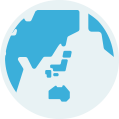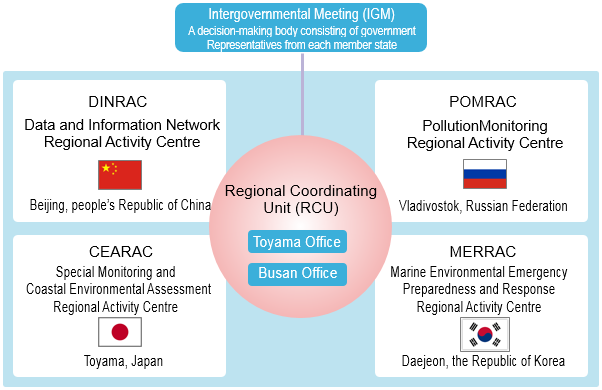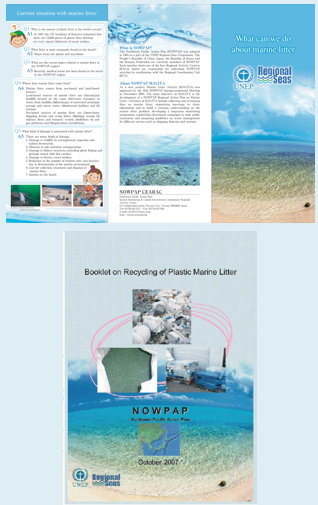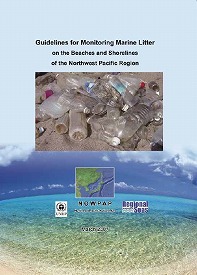 Northwest Pacific Action Plan (NOWPAP)
Northwest Pacific Action Plan (NOWPAP)
Northwest Pacific Action Plan (NOWPAP)
The Action Plan for the Protection, Management and Development of the Marine and Coastal Environment of the Northwest Pacific Region (NOWPAP), was inaugurated by the four countries of the People's Republic of China, Japan, the Republic of Korea and the Russian Federation in 1994, with the aim of protecting the environment in the Northwest Pacific Region, as part of the Regional Seas Programme of United Nations Environment Programme(UNEP).
A Regional Activity Centre (RAC) is located in each member state to implement NOWPAP activities. In addition, Regional Coordinating Unit (RCU) coordinates NOWPAP activities which are mostly implemented by the four RACs. There are two RCU offices : in Toyama,Japan and Busan, Korea.

1. Overall Goal
The wise use, development and management of the coastal and marine environment so as to obtain the utmost long-term benefits for the human populations of the region, while protecting human health, ecological integrity and the region’s sustainability for future generations
2.Member countries
4 countries of Japan, China, Kore, and Russia
3. Geographic Coverage
The geographical scope of NOWPAP covers the marine environment and coastal zones in Japan, China, Korea and Russia from about 121 degree E to 143 degree E longitude, and from approximately 33 degree N to 52 degree N latitude
4.The scale of the Trust Fund
The NOWPAP Trust Fund is established to provide the financial support for implementing projects based on the Action Plans. Each member country contributes the appropriate amounts to the Fund. The target annual amount of the total contributions is 500,000 US dollars. The total amount of contributions in 2015 was 475,000 US dollars.
5.The NOWPAP Medium-term Strategy
The issues of marine environment in the NOWPAP region have been slightly changed since the inauguration of NOWPAP. Currently, the greater attention is paid to global warming and biodiversity in the world. They are considered as the serious threats in the Northwest Pacific Region too. In the context of the current situation, in 2011 member countries agreed on the NOWPAP Medium-term Strategy for 2012-2017 and clarified issues to be addressed.
In the Medium-term Strategy, following 9 issues were listed up and each Regional Activity Center has been working on them.
- Integrated coastal and river basin management
- Regular assessments of the state of the marine environment
- Pollution prevention and reduction, including harmful substances, hazardous waste and marine litter
- Biodiversity conservation (including alien invasive species)
- Climate change impacts
- Information management
- Public awareness raising
- Regional cooperation
- Resource mobilization
6.Regional Coordinating Unit, RCU
At the 6th Intergovernmental Meeting (IGM) in December 2000, the NOWPAP member countries agreed to establish a co-hosted NOWPAP Regional Coordinating Unit, (RCU) in Toyama, Japan, and in Busan, Republic of Korea. The RCU is the nerve center and in charge of the coordination of the RACs and member countries.
7.Regional Activity Centers
As agreed at the Fourth Intergovernmental Meeting in April 1999, each NOWPAP member country hosts one Regional Activity Center (RAC), which is responsible for carrying out individual NOWPAP activities and projects approved by the Intergovernmental Meeting. (Refer to the NOWPAP Structure)
China hosts Data and Information Network Regional Activity Center (DINRAC) in Beijing, which collects various data of the ocean environment in the region, develops the database, and disseminates it. Korea hosts Marine Environmental Emergency Preparedness and Response Regional Activity Center (MERRAC) in Daejeon, which develops effective regional cooperative measures in response to marine pollution incidents including oil and hazardous and noxious substance (HNS) spills. Russia hosts Pollution Monitoring Regional Activity Centre (POMRAC) In Vladivostok, which is responsible for cooperation in regional monitoring of atmospheric deposition and rivers and direct inputs of contaminants in the region.
In Japan, NPEC was designated to host Special Monitoring and Coastal Environment Assessment Regional Activity Centre (CEARAC). Main responsibilities of CEARAC are as follows.
- Remote Sensing
We have developed environmental assessment and planning tools with special monitoring programmes, which cannot be covered by routine pollution monitoring, such as water quality measurements. We are also implementing marine and coastal monitoring by remote sensing with satellites. - Harmful Algal Brooms
We assess comprehensively the state of the marine and coastal area, and promote activities for solving problems.
We are working on indexes of occurrence of harmful algal broom, including red tide, which can cause massive damage to fish, shellfish, and the marine environment. - Eutrophication
Eutrophication is one of the indexes for water quality deterioration. We are working on the eutrophication problem with the aim of the environmental assessment by monitoring with remote sensing.
The common procedure for the eutrophication assessment among four countries has been developed and promoted to assess the eutrophication in each country. - Marine Biodiversity
Marine biodiversity is a new research theme of CEARAC. In order to establish marine protected areas (MPAs), the basic information on the existing MPAs in the NOWPAP member states are collected and shared. CEARAC has made assessments for the impacts of various environmental threats to the biodiversity.
8.Focal Point Meetings, FPM
At the 7th IGM in March 2002 it was agreed to establish a Focal Point Meeting (FPM) alongside each RAC to evaluate their activities and give them advices.
The FPM has been organized once a year with focal points representing the member countries.
~Contributions to NOWPAP Marine Litter Activities~
Reports and materials developed by NPEC have been utilized in NOWPAP activities to promote reduction of marine litter.


The four member states of NOWPAP (China, Japan, Korea and Russia) have conducted research on marine litter on the Northwest Pacific shores, using the Guidelines for Monitoring Marine Litter which NOWPAP developed based on the experience of the NPEC marine litter monitoring survey. NPEC also participates in this survey, contributing to deepen understandings on the status of marine litter in the region.
![The Northwest Pacific Region Environmental Cooperation Center[NPEC]](../images/common/header_logo.png)

